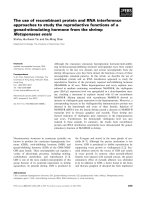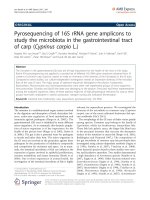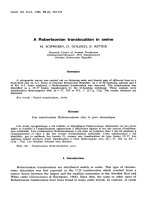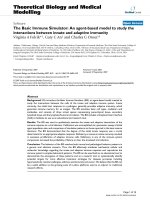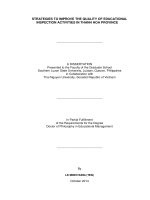Body morphometry in relation to season, sex and body weight in Vrindavani calves
Bạn đang xem bản rút gọn của tài liệu. Xem và tải ngay bản đầy đủ của tài liệu tại đây (246.35 KB, 8 trang )
Int.J.Curr.Microbiol.App.Sci (2020) 9(5): 1223-1230
International Journal of Current Microbiology and Applied Sciences
ISSN: 2319-7706 Volume 9 Number 5 (2020)
Journal homepage:
Original Research Article
/>
Body Morphometry in Relation to Season, Sex and
Body Weight in Vrindavani Calves
Sikander Shabab Khan1*, Triveni Dutt2, Amit Kumar3, Brijesh Patel1, Mukesh Singh1,
Pratik R. Wankhade1, Upender Singh1 and G. K. Gaur1
1
Livestock Production Management (LPM), ICAR-Indian Veterinary Research Institute
(IVRI), Izatnagar, Bareilly - 243 122 (U.P.), India
2
ICAR-IVRI, Izatnagar, Bareilly, India
3
Division of Animal Genetics & Breeding, ICAR-IVRI, Izatnagar, Bareilly, India
*Corresponding author
ABSTRACT
Keywords
Morphometry,
Season, Sex, Body
Weight, etc.
Article Info
Accepted:
10 April 2020
Available Online:
10 May 2020
Present investigation was carried out to study the morphometry in relation to body weight, sex and
season in Vrindavani calves. All Vrindavani calves (Age 0 to 3 month) born between August 2019 to
January 2020 were selected (N=87). Body morphometry comprising of Height at Withers (HAW),
Height at Hip bone (HAHB), Height at Pin bone (HAPB), Rump length (RL), Ischial Width at Rump
(ILWR), Medial Width at Rump (MDR), Ilial Width at Rump (ILWR), Total length (TL), Body
length (BL), Hearth Girth (HG), Fore cannon bone Girth (FCBG), Face length (FL), Face width
(FW), Ear length (EL) were measured at one month of age. The birth weight, weights after 15 days
interval were measured till 3 months of age. we observed that most of the measurements with the
exception of Heart Girth, body length, Ischial width at Rump, Face width and Ear length were
significantly (p<0.001) correlated to season of birth. The morphometric measurements are also
positively correlated (p<0.001) to sex of the calves. Body weights were significantly(p<0.001)
correlated to Body Length and Heart Girth. Most of the Morphometric measurements and Body
weights were found to be significantly (p<0.001) correlated among themselves. Heart Girth (HG, r 2
=0.80) and Body Length (BL, r2 =0.71) has significant (p<0.001) effect on Birth Weight, Weight at
15 days and 30 days of age. Body Length significantly (p<0.05) effects Body weight at 45 days
while only Heart Girth (HG) was found to be significantly (p<0.05) effecting body weight at 75 days
of age.
Introduction
Live weight (LW) forms the basis for a
number of research and management practices
including evaluation of growth rates, animal
responsiveness to different feeds and
environmental factors, and determination of
diet requirements. In breeding programs for
traits, notably weights and weight gains
obtained at different ages, are considered as
selection criteria since these traits are easy to
obtain and are positively correlated to other
traits of economic interest. These traits
respond to selection by showing heritability
estimates of medium magnitude (Boligon et
al., 2011).
1223
Int.J.Curr.Microbiol.App.Sci (2020) 9(5): 1223-1230
Precise measurement of livestock body
weight is important in deciding the weight of
slaughter, the amount of feeding and what
dose of treatment to use (Machila et al.,
2008). In addition, knowledge of animal
weight and weight changes are also important
in determining responses to genetic selection
(Touchberry and Lush., 1998), and are a key
management tool (Dingwell et al., 2006;
Ozkaya and Bozkurt., 2009). A weighing
scale is considered the gold standard among
the many methods used to assess it, if the
scales used are well configured (Machila et
al., 2008). Calves are the future replacement
stocks. In the calf rearing, the key
management objective is to ensure that calves
survive and remain healthy (Jozica et al.,
2012).However, most of the rural farmers
may be restricted by lack of technical skills in
the operation and maintenance of facilities
required for weight measuring (Dingwell et
al., 2006; Kashoma et al., 2011; Musa et al.,
2011).Farmers and cattle traders are not
accurate in estimating cattle Live Weight,
with 46 per cent underestimates and 25 per
cent overestimates reported (Machila et al.,
2008). Body measurements used to predict
Live body weight can have a direct and
indirect effect on its determination (Yakubu et
al., 2012). Heart Girth is generally accepted
as the most satisfactory single predictor of
live weight in cattle since it is closely related
to body weight (Lesosky et al., 2012; Lukuyu
et al., 2016).
Morphometric traits measurements can be a
vital tool for local farmers to make decisions
of selection and breed improvement (Salim
bhashwan., 2014). Using morphometric traits
to predict live body weight may be important
for local famers to make selection and cull
decisions, as it can be a relatively low cost,
high accuracy and consistency (Musa et al.,
2011). In some cases, morphometric
characteristics can be more accurate than
modern weighing machines, as the latter may
provide skewed measurements induced by
fullness of the gut (Obike et al., 2010).
Keeping in view the problem of dairy calf
selection at the farm level at an early stage,
the present study was undertaken to
investigate
relationship
between
morphometric measurement at one-month age
with sex and body weights of calves born in
different seasons.
Materials and Methods
Location and Climatic conditionsThe farm is
located at an altitude of 169.2 m above sea
level, at north latitude of 28022' and east
longitude of 79024'. This place falls in India's
upper Gangetic Plain Region. It usually has a
humid subtropical climate with high
temperature differences between summer and
winter. Summers are long, with the monsoon
season in between, from early April until
October. Winter starts in October and
approaches peaks in January. The extreme
temperatures fluctuate between 4 ° C and 44 °
C. The mean annual temperature is 25 ° C (77
° F), and the mean monthly temperatures
range from 14 ° C to 33 ° C (58 ° F to 92° F).
The average annual rainfall is about 1714 mm
(28.1 inches), the bulk of which occurs during
the July and August monsoon.
Experimental animals
All Vrindavani calves (Age 0 to 3 month)
born between August 2019 to January 2020
were selected. During this period approximate
87 calves were born. Body morphometry
comprising of Height at different body points,
Length and width of superficial body parts.
Hearth Girth(HG), Forecannon bone Girth
(FCBG), Face length(FL), Face width (FW),
Ear length(EL) were measured using
measuring tape and Locally made Height
scale at 30 days of age. The birth weight,
weight after 15 days interval was measured
till 3 months of age.
1224
Int.J.Curr.Microbiol.App.Sci (2020) 9(5): 1223-1230
Health and hygiene practices
All of the calves were reared during the entire
study period under strict management and
proper hygienic conditions. During the calf's
second week of age de worming and
disbudding was completed. During the time of
experimentation good sanitation of the pens,
feeding utensils, water containers and
surrounding experimental area has been
preserved. The pens were cleaned daily, and
all hygienic precautions were taken to prevent
infectious and contagious diseases from
occurring.
Housing of calves
The calves were housed individually in well
ventilated, clean and dry cemented concrete
pens for 18 hours (from 3.00 pm to 9.00 am)
throughout the experimental periods. They
were let loose for 6 hours (9.00am to 3.00
pm) daily in open paddock for exercise and
also to facilitate washing, cleaning and drying
of calf pens. Free access to fresh, clean and
wholesome water along with green fodder
was given to the calves.
Feeding schedule of calves
After colostrum feeding the calves were
maintained on whole milk. Calf starter and
roughage was provided adlib from second
weeks onwards. The feeding schedule of the
calves is presented in table 1.
Parameters recorded
Production parameters
The calves were weighed at birth (W1) and
subsequently weighed after each 15 days till 3
months of age. The weight were designated as
W1(weight at 15th
day),W2(weight at
th
th
30 day),W3(weight at 45 day),W4(weight at
60th day),W5(weight at 75th day), W6(weight
at 90th day.
The morphometry of the animal was
measured at 30 days of age. The
morphometry comprises of Height at
Withers(HAW), Height at Hip bone(HAHB),
Height at Pin bone(HAPB), Rump
length(RL), Ischial Width at Rump(ILWR),
Medial Width at Rump(MDR), Ilial Width at
Rump(ILWR), Total length(TL), Body
length(BL), Hearth Girth(HG), Fore cannon
bone Girth (FCBG), Face length(FL), Face
width (FW), Ear length(EL). The definition of
body morphometry is given as per Table 2.
Statistical analysis
The information collected by data sheet
would be pooled and analyzed as per standard
statistical procedure (Snedecor and Cochran,
1989). Statistical analysis was done by
appropriate method with SAS Enterprize
guide 4.3.
Results and Discussion
The mean+SD, mode and range of different
body morphometric measurements and
weights is given in Table 3. Correlation of
body morphometry is given in Table 4. The
body morphometric measurements are
correlated to season of birth of Calves.
However, most of the measurements with the
exception of Heart Girth, Body length, Ischial
width at Rump, Face width and Ear length
were correlated to season at 0.01% level.
In earlier findings, the effect of season on
morphometry was limited to body length and
pre-weaning relative gain (Karna et al., 2001).
The correlation of BW with HG at various
ages for Tanzania Shorthorn Zebu cattle were
in the range of 0.65–0.94 (Kashoma et al.,
2011). The morphometric measurements are
also positively correlated (p<0.001) to sex of
the calves with the exception of Ilial width at
Rump, Ischial width at Rump, Ear length and
Fore cannon bone girth.
1225
Int.J.Curr.Microbiol.App.Sci (2020) 9(5): 1223-1230
Table.1 Feeding schedule of the calves at calf section of IVRI
Days
0-3
4-56
57-63
64-72
Colostrum
1/10th Colostrum
__
__
__
Whole milk
__
th
1/10 of BW
1/20th of BW
1/40th of BW
Table.2 Definitions of body measurements (Rana et al., 2009)
S.No. Morphometric trait
Height at wither (HAW)
1
Description
Vertical distance from ground to the highest point
of the Withers.
2
Body length (BDL)
Oblique distance between tip of the Shoulder to
the tip of the Pin bone.
3
Heart girth (HG)
Circumference of chest just behind the point of
Elbow.
4
5
6
Face length (FL)
Face width (FW)
Ear length (EL)
Distance between polls to upper edge of Muzzle.
Maximum distance between both the Eyes.
Length of lower surface of Ear measured from tip
to junction of Ear to Face.
7
Fore cannon
(FCBG)
8
Height at hipbone (HAHB)
Vertical distance from ground to the highest point
of Hip bone.
9
Height at pin bone (HAPB)
Vertical distance from ground tothe highest point
of Pin bone.
10
Rump slope (RS)
Difference of height at Hipbone and height at Pin
bone.
11
Rump length(RL)
Distance between the tip of the Ilium and the tip
of the Ischium.
12
Ischium Width of the Rump
(ISWR)
Measured between
Ischium(Pinbones).
13
Ilium width of the rump Measured between the two tips of the Ilium
(ILWR)
(Hipbones).
14
Medium
(MWR)
15
Top line (TPL)
width
bone
of
girth Circumference of left Cannon bone in the middle.
the
two
tips
of
the
rump Measured between the trochanter (coxofemoral
articulation).
It is the total length of the animal from the front
of the poll to the back of the Rump.
1226
Int.J.Curr.Microbiol.App.Sci (2020) 9(5): 1223-1230
Table.3 Mean, Mode and Range of Morphometric measurements and Body Weights
Variable
HAW(cm)
HAHB(cm)
HAPB(cm)
RL(cm)
ILWR(cm)
MDR(cm)
ISWR(cm)
TL(cm)
BL(cm)
HG(cm)
FCBG(cm)
FL(cm)
FW(cm)
EL(cm)
birth wt.(Kg)
W1(Kg)
W2(Kg)
W3(Kg)
W4(Kg)
W5(Kg)
W6(Kg)
Mean±SE
69.83±0.73
72.64±0.80
67.71±0.75
21.91±0.29
16.21±0.33
19.16±0.27
11.78±0.15
89.55±1.45
94.85±1.23
96.58±1.28
11.56±0.11
19.82±0.40
13.46±0.22
13.22±0.12
21.22±0.44
23.30±0.46
26.85±0.48
30.74±0.66
36.53±0.88
43.57±1.19
49.65±1.76
Mode Range
67.82 32.00
69.60 33.53
64.01 51.56
21.08 14.73
14.48 16.26
18.29 12.70
10.67
6.86
83.82 66.04
85.60 58.33
74.65 63.18
9.14 86.11
17.78 14.48
12.95 10.16
12.95
5.08
24.00 24.00
22.00 19.00
26.00 24.00
30.00 34.00
32.00 36.00
42.00 41.00
42.00 42.00
Table.4.1 Correlation between Morphometric measurements and other parameters
Morphometry season
HAW
HAHB
HAPB
RL
ILWR
MDR
ISWR
TL
BL
HG
FCBG
FL
FW
EL
0.31a
0.37a
0.35a
0.22c
0.26c
0.30a
0.09
0.09
-0.02
-0.13
0.22c
0.22c
0.20
0.03
sex
0.25c
0.38a
0.30b
0.23c
0.20
0.3b
0.08
0.36a
0.12
0.14
-0.12
0.25c
0.33b
-0.06
Birth
weight
0.13
0.14
0.11
0.09
-0.01
0.14
0.16
0.09
0.74a
0.82a
0.15
-0.003
0.09
0.14
W1
W2
W3
W4
W5
W6
0.18
0.13
0.15
0.07
-0.01
0.20
0.01
0.14
0.77a
0.72a
0.10
0.01
0.19
0.11
0.12
0.15
0.10
0.05
0.00
0.18
0.01
0.14
0.61a
0.63a
-0.01
0.006
0.1
0.06
0.17
0.15
0.12
0.10
0.09
0.23
0.07
0.21
0.42a
0.52a
0.01
0.07
0.16
0.08
0.22
0.16
0.13
0.15
0.15
0.29c
0.22
0.27c
0.41b
0.45c
0.04
0.16
0.14
0.17
0.10
0.07
0.03
0.09
0.13
0.22
0.21
0.16
0.29c
0.32c
0.01
0.07
0.03
0.18
-0.05
-0.12
-0.15
0.09
0.10
0.11
0.20
-0.02
0.00
0.00
0.05
-0.02
-0.18
0.37
Significant Correlation at a,0.1% and b, 1% and c,5% respectively
1227
Int.J.Curr.Microbiol.App.Sci (2020) 9(5): 1223-1230
Table.4.2 Correlation among Morphometric measurements
HA
W
1
0.79a
HAH
B
1
HAP
B
-
RL
ILW
R
-
MD
R
-
ISW
R
-
HAW
HAH
B
1
HAPB 0.73a 0.53a
0.87a 0.75a
0.54a
1
RL
0.57a
0.88a 1
ILWR 0.85a 0.80a
0.88a 0.82a
0.57a
0.89a 0.90a 1
MDR
a
a
a
a
a
a
0.60
0.53
0.66
0.73
0.73
1
ISWR 0.66
0.82a 0.75a
0.55a
0.84a 0.87
0.88a 0.64a
TL
0.12
0.14
0.09
0.14
0.05
0.18
0.20
BL
0.11
0.03
0.23c
0.03
-0.03 0.07
0.11
HG
0.08
0.02a
0.03
-0.02 0.07
0.05
FCBG 0.16
0.86a 0.74 a
0.70a
0.81a 0.90a 0.84a 0.72a
FL
0.89a 0.74 a
0.67a
0.83a 0.79a 0.83a 0.53a
FW
0.19
0.09
0.08
0.25c 0.18c 0.24c 0.23c
EL
Significant Correlation at (a, 0.1%),(b, 1%) and (c, 5%) respectively
TL
BL
HG
FCB
G
FL
FW
-
-
-
-
-
-
1
0.12
0.10
-0.02
0.85
0.78
0.15
1
0.64a
0.14
0.06
0.09
0.13
1
0.12
0.00
0.08
0.16
-
1
0.80a
0.19
1
0.13
-
-
1
0.03
0.00
-0.12
Table.4.3 Correlation among Body Weights
Birth wt.
W1
W2
W3
W4
W5
W6
Birth wt.
0.88a
0.75a
0.62a
0.57a
0.43b
0.04
W1
0.88a
0.77a
0.73a
0.60a
0.18
W2
0.91a
0.85a
0.76a
0.42c
W3
0.93a
0.87a
0.66b
W4
0.93a
0.78a
W5
0.91a
Significant Correlation at (a, 0.1%), (b, 1%) and (c, 5%) respectively.W1(weight at 15 th day),W2(weight at
30thday),W3(weight at 45th day),W4(weight at 60th day),W5(weight at 75th day), W6(weight at 90th day
There is also positive correlation among most
of morphometric measurements and body
weights as shown in Table 3 and 4. Analysis
of variance reveals that Heart Girth (HG, r2
=0.80) and Body Length (BL, r2 =0.71) has
significant (p<0.001) effect on Birth Weight,
Weight at 15 days and 30 days of age.
However, Body Length significantly (p<0.05)
effects Body weight at 45 days. Subsequently
weight at 60 and 90 days of age is not
effected by one month morphometric
measurements while at 75 days, only Heart
Girth (HG) was found to be significantly
(p<0.05) effecting body weight.
The birth weight significantly (p<0.001)
effects future milk production in Iranian
Holstein calves (Ghoraishy and Rokouei.,
2013). In addition, calves with higher birth
weight have higher growth rate compared to
those with lower birth weight (Boligon et al.,
2010; Coffey et al., 2006).
Furthermore, calves with higher body weight
had higher persistency than low body weight
calves (Lamb and Barker., 1975). However in
Egyptions Buffaloes calf body weight
between 30-50kg had no significant (p<0.05)
effect on milk yield (Hamad and Moghazy,
1228
Int.J.Curr.Microbiol.App.Sci (2020) 9(5): 1223-1230
2015) while in Holstein calves, birth weight
between 20 and 60 kg significantly effects
305 days Milk yield (Rahbar el al., 2016).
Birth weight is a better indicator of growth
after weaning than is rate of growth to
weaning at 500 Ibs. Birth weight has an even
higher relationship with days from birth to
900 pounds body weight (Dawsen et al.,
1947).
From the above experiment, it can be said that
out of all the morphometric measurements
heart girth and body length directly affect
body weight of the calves. Similar results
were also reported in Dhofari calves where
Heart Girth was found to be significantly
(p<0.05) correlated(r=0.957) to live body
weight. (Salim Bahashwan., 2014).
In conclusion, information on morphometry is
vital and valuable in management and
breeding programs and should be well utilized
to improve the performance of Vrindavani
cattle breeds. Heart Girth appears to be a
highly specific indicator of body weight since
it was more likely to influence body weight at
later ages. However, Body Length is also
associated to weight at some point of time
during early life. For this reason, body
morphometrical measurements are useful to
identify animals with rapid gain ability. These
measurements could be integrated into future
studies of prediction of body weight in
relation to season and sex so that animals can
be selected at an earlier stage.
References
Boligon, A.A., M. E. Z. Mercadante, S. Forni,
R. B. L. Lobo and Albuquerque, G.
2010. Covariance functions for body
weight from birth to maturity in Nellore
cows. Journal of Animal Science.
88:849-859.
Boligon, A.A., F. Baldi, and Albuquerque,
L.G. 2011. Genetic parameters and
relationships between growth traits and
scrotal circumference measured at
different ages in Nellore cattle. Genetics
and Molecular Biology. 34(2) 225-230.
Coffey, M. P., J. Hickey, and Brotherstone, S.
2006. Genetic aspects of growth of
Holstein-Friesian dairy cows from birth
to maturity. Journal of Dairy Science.
89:322-329.
Dawson, W. M., R. W. Phillips, and Black,
W. H. 1947. Birth Weight as a Criterion
of Selection in Beef Cattle. Journal of
Animal Science. 6(3): 247–257.
Dingwell, R.T., M. M. Wallace, C. J.
McLaren, C. F. Leslie and Leslie, K. E.
2006. An evaluation of two indirect
methods of estimating body weight in
Holstein calves and heifers. Journal of
Dairy Science. 89:3992–3998
Ghoraishy S. H., and Rokouei, M. 2013.
Impact of birth weight of Iranian
Holstein calves on their future milk
production and reproductive traits.
Journal of Livestock Science and
Technologies 1:39-44.
Hamed, M . N . F., and El-Moghazy, M . M.
2015. Influence of sex and calf weight
on milk yield and some chemical
composition in the Egyptian buffalo's.
Journal of Animal and Veterinary
science 2:22- 27.
Jozica, J., M. Tadej, M. and Martina, K. 2012.
Serum immunoglobulin (IgG, IgM,
IgA) concentration in cows and their
calves. 20th Int. Symp. “Animal
Science
Days”,
Kranjska
gora,
Slovenia, Sept. 19th-21th, ACTA
AGRIC. SLOV.3:295-298
Karna, D., G. L. Koul, and Bisht, G. 2001.
Birth weight, morphometry and relative
gain in body weight of Cheghu kids.
The Indian journal of animal sciences.
71. 180-182.
Kashoma, I.P.B., C. Luziga, C. W. Werema,
G. A. Shirima, and Ndossi. D. 2011.
Predicting body weight of Tanzania
1229
Int.J.Curr.Microbiol.App.Sci (2020) 9(5): 1223-1230
shorthorn zebu cattle using heart girth
measurements. Livst Res Rural Dev
23:94.
Lesosky, M., S. Dumas, I. Conradie, I. G.
Handel, A. Jennings, S. Thumbi, P.
Toye, and Bronsvoort B. M. C. 2012. A
live weight-heart girth relationship for
accurate dosing of east African
shorthorn zebu cattle. Trop Animal
Health and Production 45:311–316.
Lukuyu, M.N., J. P. Gibson, D.B. Savage, A.
J. Duncan, F. D. N. Mujibi, and Okeyo,
A.M. 2016. Use of body linear
measurements to estimate liveweight of
crossbred dairy cattle in smallholder
farms in Kenya. SpringerPlus. 5:63.
Machila, N., E. M. Fevre, I. Maudlin, and
Eisler, M.C. 2008. Farmer estimation of
live body weight of cattle: implications
for veterinary drug dosing in East
Africa. Prev Vet Med. 87:394–403.
Musa, A.M., K. M. Elamin, S.A. Mohammed,
and Abdalla, H.O. 2011. Morphometric
traits as indicators for body weight in
Sudanese Kenana cattle. Online J Anim
Feed Res 1:218–222.
Rahbar, R., R. Abdullahpour, and SadeghiSefidmazgi, A. 2016. Effect of Calf Birth
Weight on Milk Production of Holstein
Dairy Cattle in Desert Climate. J Anim
Behav Biometeorol. 4(3) p.65-70.
Obike, O. M., S. N. Ibe, and Oke, U. K. 2010.
Estimation of pre and post-weaning
body weight of rabbit in humid tropical
environment
using
linear
body
measurement. American- Eurasian
journal
of
Agriculture
and
environmental Science. (4): 440-444.
Ozkaya, S and Bozkurt, Y. 2009. The
accuracy of prediction of body weight
from body measurements in beef cattle.
Archiv Tierz. 52:371–377.
Bahashwan, S., 2014. Application of
Morphometric Traits for Live Body
Weight Estimation in Dhofari Calves.
International Journal of Scientific
Research in Agricultural Sciences, 1(5),
pp. 90-96.
Touchberry, R.W., And Lush, L.W. 1998.
The Accuracy of Linear Body
Measurements of Dairy Cattle. Iowa
Agricultural Experiment Station, Ames.
Ulutas, Z ., I. A. Dewi, and Saatci, M. 2002.
Genetic
parameters
of
weights,
ultrasonic muscle and fat depths,
maternal effects and reproductive traits
in Welsh Mountain sheep. Animal
Science. 74: 399-408.
Yakubu, A. and Mohammed, G.L., 2012.
Application
of
path
analysis
methodology
in
assessing
the
relationship between body weight and
biometric traits of Red Sokoto goats in
northern Nigeria. Biotechnology in
Animal Husbandry. 28(1): 107-117.
How to cite this article:
Sikander Shabab Khan, Triveni Dutt, Amit Kumar, Brijesh Patel, Mukesh Singh, Pratik R.
Wankhade, Upender Singh and Gaur. G. K. 2020. Body Morphometry in Relation to Season,
Sex and Body Weight in Vrindavani Calves. Int.J.Curr.Microbiol.App.Sci. 9(05): 1223-1230.
doi: />
1230

